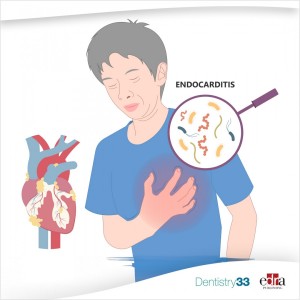
Oral hygiene and bacterial endocarditis
Lara Figini
Infectious bacterial endocarditis (IE), typically encountered as heart valve infection, is rare in the general population but associated with high morbidity and mortality.
It was first suggested more than 100 years ago that oral bacteremia could cause IE.
In 1955, the first American Heart Association (AHA) guidelines on the prevention of IE recommended that patients at increased risk of IE receive prophylactic antibiotics before undertaking invasive dental procedures.
However, in 2007, the AHA reversed this recommendation for those considered to be at moderate risk for complications from IE, a cohort comprising approximately 90% of people with valvular heart disease, recommending antibiotic prophylaxis only for high-risk individuals undergoing IE.
These recommendations were maintained in the 2021 Cardiology Guidelines from the AHA/American College. Most of the dental plaque involves streptococci (for example, S. mitis) and under healthy conditions the gingival crevice around the teeth is lined with a thin layer of highly permeable non-keratinized epithelium which separates potentially pathogenic organisms from the general circulation.
The accumulation of dental plaque and tartar results in bacterial growth, gingival inflammation, ulceration and increased permeability of the crevicular epithelium which probably lead to an increased frequency of bacteremia.
There is growing evidence in the literature that frequent bacteremia due to plaque and tartar is probably associated with an increased risk of IE.
Materials and methods
In a case control study published in March 2023 in Oral Surgery Oral Medicine Oral Pathology Oral Radiology, the authors determined whether oral hygiene was associated with infective endocarditis (IE) among individuals at moderate risk for IE. In this study, hygiene was investigated in hospitalized patients with IE (cases) as compared with outpatients with valvular heart disease but without IE (controls).
The primary endpoint was the mean dental calculus index. Secondary objectives have included other oral hygiene measures and periodontal disease (e.g., dental plaque, gingivitis). Blood culture categorization of bacterial species was also performed.
Results
The 62 participants in the case group had a mean dental tartar index 53% higher than the 119 participants in the control group (0.84, 0.55, respectively; difference = 0.29, 95% CI: 0.11, 0.48; p = 0.002) and 26% mean index of major dental plaque (0.88, 0.70, respectively; difference = 0.18, 95% CI: 0.01, 0.36; p = 0.043).
Overall, cases reported fewer dental and dental hygiene visits (p = 0.013) and fewer dental visits in the 12 weeks prior to enrollment in the study than controls (p = 0.007).
Common oral bacteria were identified from blood cultures in 27 of 62 cases (44%).
Conclusions
From the data of this study, researchers concluded that in people at risk of bacterial endocarditis, it is possible to reduce the potential sources of bacterial endocarditis related to it by maintaining optimal oral health through regular professional dental care and procedures constant and correct home oral hygiene.
For more information: "Oral hygiene and infective endocarditis: a case control study."
 Related articles
Related articles
Endodontics 03 October 2023
Infective endocarditis is an infection of the endocardium, usually of bacterial origin (frequently due to streptococci or staphylococci) and sometimes fungal.
Oral Hygiene & Prevention 08 September 2023
How well do dental hygienists understand infective endocarditis prevention?
Infective endocarditis is a rare infection of the endocardium and heart valves, with a mortality rate that is high. Over the years, this has led to the development of specific guidelines with the...
Researchers examined the plaque removal effectiveness of a personalized 3D-printed dental plaque removal mouthguard device in a clinical trial.
Pediatric dentistry 16 May 2023
Microbial indicators of dental health, dysbiosis and early childhood caries
Dental caries lesions are a clinical manifestation of disease, preceded by microbial dysbiosis, which is poorly characterized and thought to be associated with saccharolytic taxa. Here, researchers...
Periodontal disease is a chronic inflammatory disease that affects the periodontium and is classified into gingivitis and periodontitis with reversible and irreversible tissue damage.
 Read more
Read more
Editorials 10 October 2025
With proud smiles and crisp white coats, ninety-three learners from the DDS Class of 2029 and the International Dentist Pathway Class of 2028 marked the start of their dental careers at the UCSF...
Periodontology 10 October 2025
Continuous professional development (CPD) in Periodontology refers to the overall framework of opportunities that facilitate a life-long learning practice, driven by the learner-practitioner and...
TheraBreath, the #1 alcohol-free mouthwash brand in the U.S.*, has introduced a new line of dentist-formulated, clinically tested toothpastes designed to support professional oral care...
News 10 October 2025
New officers and trustees were installed at the Minnesota Dental Association’s Leadership Conference on September 19 in Minneapolis.
News 10 October 2025
Smartee Denti-Technology today announced that Professor Gang Shen, its Chief Scientist and Executive President of TaiKang ByBo Dental, has once again been named to the World’s Top 2% Scientists...















